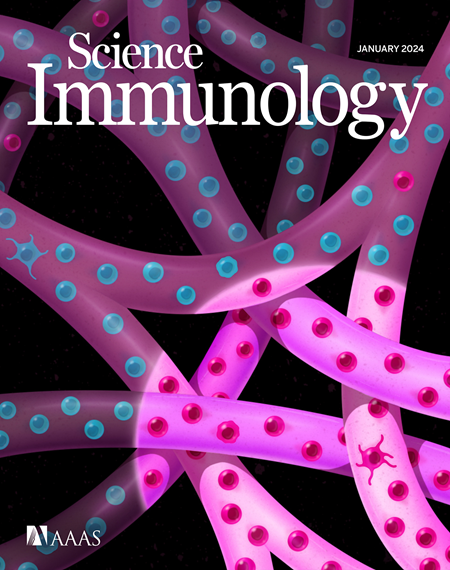核碱基加合物与 MR1 结合并刺激 MR1 限制性 T 细胞。
IF 17.6
1区 医学
Q1 IMMUNOLOGY
引用次数: 0
摘要
MR1T 细胞是最近发现的一类 T 细胞,它们能在没有微生物感染的情况下识别由主要组织相容性复合体 I 相关分子 MR1 呈递的抗原。刺激 MR1T 细胞的自身抗原的性质仍不清楚,这妨碍了我们对其生理作用和治疗潜力的了解。通过结合遗传学、药理学和生物化学方法,我们发现靶细胞中的羰基应激和核碱基代谢变化会促进 MR1T 细胞的活化。在肿瘤细胞产生的 MR1 分子中检测到了由核碱基的羰基加合物形成的刺激性化合物,诱导羰基积累的药物增强了这些化合物的丰度和抗原性。我们的数据揭示了羰基核碱基加合物是 MR1T 细胞抗原。通过识别羰基压力下的细胞,MR1T 细胞可以监测细胞代谢变化,从而产生生理和治疗意义。本文章由计算机程序翻译,如有差异,请以英文原文为准。
Nucleobase adducts bind MR1 and stimulate MR1-restricted T cells
MR1T cells are a recently found class of T cells that recognize antigens presented by the major histocompatibility complex-I–related molecule MR1 in the absence of microbial infection. The nature of the self-antigens that stimulate MR1T cells remains unclear, hampering our understanding of their physiological role and therapeutic potential. By combining genetic, pharmacological, and biochemical approaches, we found that carbonyl stress and changes in nucleobase metabolism in target cells promote MR1T cell activation. Stimulatory compounds formed by carbonyl adducts of nucleobases were detected within MR1 molecules produced by tumor cells, and their abundance and antigenicity were enhanced by drugs that induce carbonyl accumulation. Our data reveal carbonyl-nucleobase adducts as MR1T cell antigens. Recognizing cells under carbonyl stress allows MR1T cells to monitor cellular metabolic changes with physiological and therapeutic implications.
求助全文
通过发布文献求助,成功后即可免费获取论文全文。
去求助
来源期刊

Science Immunology
Immunology and Microbiology-Immunology
CiteScore
32.90
自引率
2.00%
发文量
183
期刊介绍:
Science Immunology is a peer-reviewed journal that publishes original research articles in the field of immunology. The journal encourages the submission of research findings from all areas of immunology, including studies on innate and adaptive immunity, immune cell development and differentiation, immunogenomics, systems immunology, structural immunology, antigen presentation, immunometabolism, and mucosal immunology. Additionally, the journal covers research on immune contributions to health and disease, such as host defense, inflammation, cancer immunology, autoimmunity, allergy, transplantation, and immunodeficiency. Science Immunology maintains the same high-quality standard as other journals in the Science family and aims to facilitate understanding of the immune system by showcasing innovative advances in immunology research from all organisms and model systems, including humans.
 求助内容:
求助内容: 应助结果提醒方式:
应助结果提醒方式:


